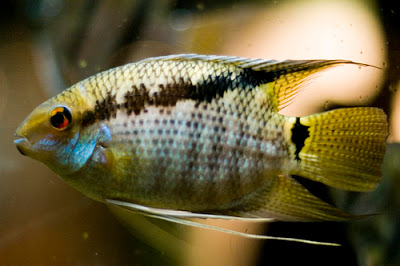Fish data : Electric Blue Jack Dempsey Cichlid
The Electric Blue Jack Dempsey cichlid Rocio octofasciata cf. (previously Cichlasoma octofasciatum) is considered to be one of the most beautiful freshwater aquarium fish. The adult displays a magnificent blue colouration, and is definitely one of the 'bluest' freshwater fish in the hobby. It has a dark brown background that is covered with brilliant metallic and iridescent blue flecks. It will reach a maximum length of a little more than 8" (20 cm), or slightly smaller than its genetic progenitor, the Jack Dempsey. These fish are also called the Blue Dempsey, Electric Blue Dempsey, and Jack Dempsey Neon Blue.
This dazzling fish is a naturally occurring variant of the Jack Dempsey. According to popular rumour, fry which displayed the bright blue colouring of the Electric Blue Jack Dempsey were considered to be malformed and runtish and were discarded by their keepers as inferior specimens. Fortunately for those hobbyists who appreciate the stunning colouration of these fish, and for the hobby in general, this archaic and incorrect view has been largely discarded, and these fish are now actively bred and developed in captivity. Though the Blue Dempsey is relatively easy to produce. It does take a considerable amount of time, luck, and a well-designed aquarium set up. So these fish are somewhat rare and quite a bit more expensive than much other tropical fish, including the Electric Blue Jack Dempsey's progentitor species, the Jack Dempsey.
The Blue Dempsey is a bit more delicate than its parentage. But just like its progenitors, it likes a tank bottom of fine sand to burrow in and create nests out of. It also needs plenty of hiding places among rocks and wood, and a cover of floating plants. However they will enjoy snacking on any plants in the aquarium, so it is recommended to monitor the status of any plants sharing the tank with a Blue Dempsey.
This cichlid, true to its family, tends to be semi-aggressive and will appreciate being kept in a large aquarium with similarly sized and tempered tankmates. That being said, it generally is not quite as aggressive as many cichlids and can be shy at times. Thus, it is best to either keep it singly or in a large group with only a few other tankmates.
The Jack Dempsey Rocio octofasciata (previously Cichlasoma octofasciatum) was described by Regan in 1903. This species is not listed on the IUCN Red List. They are found in North and Central America; Southern Mexico, Guatemala, Yucatan, and Honduras. Feral populations have been found in the USA, Australia, and Thailand as well. They inhabit bogs and other warm, slow-moving, and swampy waters, living among weedy areas with sandy or muddy bottoms. They feed on worms, crustaceans, insects and fish.
The Electric Blue Jack Dempsey is a naturally occurring colour-morph of the Jack Dempsey which has often been bred in captivity. It is said that for a long time hatched fry with this bluish colouration were consider runts and were discarded. This is no longer the case, and in fact, the chip which displays the Electric Blue colouring usually sell for higher prices when mature. They are relatively easy to breed but take a lot of time and the right set-up, so they are more rare and costly than their parentage. Other common names are Blue Dempsey, Electric Blue Dempsey, and Jack Dempsey Neon Blue.
Just like its parentage, the body of the Electric Blue Jack Dempsey is stocky and compact. However, this variety is a little smaller reaching closer to the 8 inches (20 cm) in length, rather than the almost 10 inches (25 cm) of a full-size Jack Dempsey fish. They generally have a life span of 10 - 15 years.
This beautiful variant exhibits a colouration comprised of mostly 'blues' rather than the 'greens' seen on the normal Dempsey cichlid. They have a dark brown background contrasted with brilliant metallic and iridescent blue flecks. Males develop long pointed dorsal and anal fins and may also have a round black spot in the centre of the body and at the base of the tail. Juveniles are less brilliant, having a white to the light tan background with faint turquoise to blue flecks that get bolder with age.
If stressed or moody, these fish can exhibit a significant colour change in the aquarium, and also with age. Stressed fish will be lighter, and their spots will be less striking.
A minimum 40-gallon aquarium is suggested, though a larger tank would be indicated if keeping them in a semi-aggressive community tank with other like-sized fish. They need good water movement along with reliable and efficient filtration.
Although Dempsey's can tolerate a relatively wide range of conditions, it has been suggested that warmer temperatures lead to more aggression in this fish. Many aquarists will keep the maximum aquarium temperature below 78° F (26° C) to help reduce antagonism.
Provide a bottom of fine sand and plenty of hiding places among rocks and wood. Plants are appreciated but should be hardy, such as Sagittaria. Place the plants around the inside perimeter, leaving an open area in the centre for swimming. The plants should be potted to protect the roots.
The Electric Blue Jack Dempsey is a rewarding specimen for the aquarist as it is moderately easy to keep as long as the aquarium is maintained.
Though the aggressively territorial Jack Dempsey is not considered a good community fish due to their proclivity to defend their territory, the Electric Blue Jack Dempsey has demonstrated a much more tolerant attitude towards tankmates. That being said, as this fish ages, it can tend to become more territorial and aggressive, especially when it is time for them to spawn. If they become too aggressive to cohabitate with the other members of the tank, it is recommended they be transferred to a species only tank. If keeping more than one, it is easier and safer for them to keep them in large groups rather than in pairs.
The author has successfully kept an adult Electric Blue Jack Dempsey with a 12" Peacock Eel, a 10" Chocolate Plecostomus, and a 4" Upside-down Catfish for several years. They get along very well.
The Electric Blue Jack Dempsey Cichlid has been bred in captivity. They are one of the easiest cichlids to get to spawn, but as pairs, they can become territorial, intolerant, and biters.
The Dempsey fish are egg layers. The female will lay 500-800 eggs on carefully cleaned rocks. They form a nuclear family. The fry are kept in pits and are guarded by both the male and female in the manner of "monogamous cichlid" breeders.
They are subject to infections as well as other diseases that ail all freshwater fish. One common problem is Ich. It can be treated with the elevation of the tank temperature to 86° F (30° C) for a few days since they can tolerate higher temperatures. They are prone to the same diseases as discus. Head and Lateral Line Erosion (HLLE), which was previously called "hole-in-the-head" disease. Is standard with poor water conditions. HLLE presents as cavities or pits on the head and face. It is believed this may be caused by a nutritional deficiency of one or more of Vitamin C, Vitamin D, calcium, or phosphorus. Besides, it is thought to be caused by a poor diet or lack of variety, lack of partial water changes, or over filtration with chemical media such as activated carbon.
As with most fish, the Blue Dempsey Cichlids are prone to skin flukes and other parasitic infestations (protozoa, worms, etc.), fungal infections, and bacterial infections. It is recommended to read up on the common tank diseases. Knowing the signs and catching and treating them early makes a huge difference. For information about freshwater fish diseases and illnesses
Credit :
http://www.cichlids.com/uploads/tx_usercichlids/user_pics/1368/1368____file_01_dads_pics_1_491.jpg
http://animal-world.com/encyclo/fresh/cichlid/ElectricBlueJackDempsey.php



Comments
Post a Comment